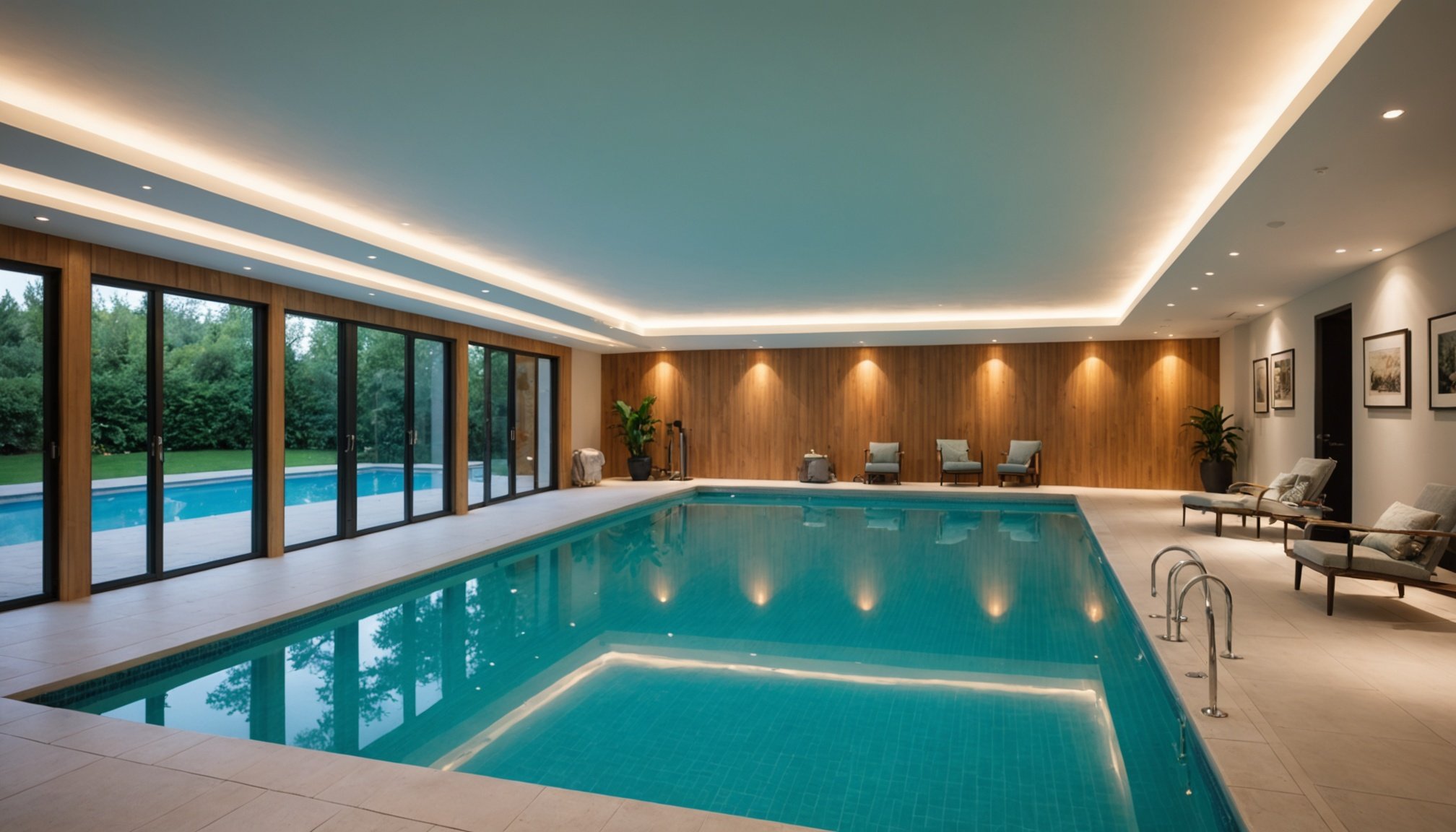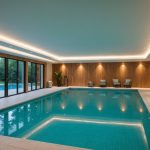Understanding Indoor Pool Acoustics
In indoor swimming pools, managing indoor pool acoustics presents unique challenges. Hard surfaces and high ceilings amplify sounds, creating echoing effects that make casual conversations difficult. This acoustic environment can often lead to discomfort, with elevated noise levels impacting the overall atmosphere.
Noise reduction strategies are essential in tackling these acoustic issues. Materials like acoustic panels and baffles, which absorb sound, can be integrated to soften echoes and improve the sound quality. In addition, designing the space with sound-dampening features can significantly enhance user experience.
Sujet a lire : Transform Your UK Swimming Pool Atmosphere: Mastering Mood Lighting with Color LED LEDs
The presence of excessive noise can also affect relaxation and safety. High noise levels can drown out important auditory cues such as spoken instructions or emergency signals, potentially impacting user safety. Conversely, environments with enhanced sound quality promote relaxation, allowing users to enjoy the pool more peacefully.
Focusing on improving indoor pool acoustics not only fosters a more pleasant and safer environment but also enhances the overall experience for users of all ages. Addressing these acoustic challenges ensures that pools are more inviting and user-friendly, supporting both leisure and safety with improved noise reduction strategies.
Lire également : Ultimate Guide to Ensuring Your Poolside Furniture Stands Up to the UK”s Unpredictable Weather
Acoustic Treatment Options
Reducing noise in swimming pool areas is crucial for creating a pleasant environment. Effective acoustic treatment and noise control go beyond aesthetics, focusing on high-performance sound-absorbing materials.
Types of Sound-Absorbing Materials
A variety of sound-absorbing materials can be used around swimming pools. These include specialized acoustic panels, which are excellent for decreasing echo and reverberation. They are designed to manage sound waves efficiently. There are several options, ranging from natural materials, like wood fibre and recycled cotton, to synthetic solutions such as foam and fiberglass. Natural options are environmentally friendly, offering sustainability benefits, while synthetic variants often provide superior durability and moisture resistance.
Installation Techniques
Installation of acoustic treatments requires attention to detail and proper planning for maximum effectiveness. Focus on areas with the highest noise levels, like ceilings and walls near high-traffic zones. Integrating these materials into pool design not only improves aesthetics but also enhances sound quality without disrupting the architectural flow.
Cost Considerations
Budgeting for acoustic improvements can be challenging, but affordable options exist if you look for cost-effective materials without compromising quality. Investing in soundproofing offers long-term benefits by improving user experience and potentially increasing property value. Additionally, researching potential grants or financial assistance could offset renovation costs.
Design Considerations for Acoustic Improvement
When planning a pool design, architectural acoustics play an essential role in the overall acoustics of an indoor environment. The sound quality within a space is largely influenced by the architectural design and sound distribution strategies.
Ceiling height and shape are significant factors in determining how sound behaves in a pool area. Tall ceilings allow sound waves to travel further, which might lead to echoes or reverberation. Curved or irregularly shaped ceilings can help break up sound waves, minimizing these issues and improving the overall acoustic performance.
There are multiple design strategies to manage sounds better within indoor environments. Incorporating sound-absorbing materials such as acoustic panels, strategically placing baffles or sound diffusers, and opting for soft, porous surfaces can drastically reduce unwanted noise reflections. Additionally, using water features and plants can help dissipate sound energy, providing a more serene atmosphere.
Considering these elements in the pool design ensures a balanced sound environment, enhancing both the acoustic experience and aesthetic appeal. Architectural acoustics, when thoughtfully integrated, contribute significantly to the comfort and enjoyment of the indoor area.
Product Recommendations
In the UK, finding effective acoustic products and soundproofing solutions for indoor pools is essential for reducing noise. These products not only enhance privacy but also improve the ambiance in pool areas.
Top Recommended Acoustic Panels
To ensure a serene environment in indoor pools, acoustic panels are essential. They absorb echoes and reduce noise levels significantly. When choosing panels, consider their material durability and water resistance. High-quality panels maintain their effectiveness even in humid environments, making them preferable. UK suppliers offer a variety of choices, from fibreglass to polyester panels, designed specifically for moisture-prone areas.
Flooring and Surface Treatments
Soundproof flooring solutions in pool areas are critical for minimising impact noise. Using materials like rubber or cork can significantly reduce noise transmission. Additionally, water-resistant surface treatments are recommended to protect floors from moisture damage while enhancing their durability. UK suppliers offer diverse options that cater to both soundproofing and protective needs.
Innovative Acoustic Technologies
Advanced technologies bring new possibilities to indoor pool acoustics. Smart sound solutions allow for automated noise control, adapting to the environment. Future trends focus on integrating these technologies seamlessly into pool designs, offering improved user experiences and increasing the practicality of soundproofing in indoor spaces.
Case Studies and Visual Aids
When delving into acoustic evaluation of pool projects, UK case studies offer insightful learning opportunities. Consider a swimming pool in Manchester, where innovative acoustic strategies significantly enhanced users’ experience. Prior to intervention, the acoustics suffered from excessive echo and noise, impeding enjoyment for pool-goers.
Acoustic Evaluation Strategies
Following acoustic evaluation and modelling, professionals implemented custom sound absorption panels. These panels were crucial in reducing sound reverberation, facilitating an enhanced auditory environment. The case study demonstrates how specific methods tailor sound management to the space’s unique characteristics.
Photographic Before-and-After
Visual aids are vital in comprehending these transformations. Photographs detailing before and after the acoustic treatments vividly illustrate the space’s metamorphosis. The previously stark, echo-laden interior evolved into a serene and inviting pool area post-installation.
Key Learnings
Key learnings from these case studies highlight the importance of thorough acoustic evaluation in planning stages. Effective use of visual aids ensures clear communication with clients, fundamentally supporting informed decision-making. In essence, these remarkable installations exemplify how tailored acoustic solutions can significantly improve facilities and user satisfaction.











